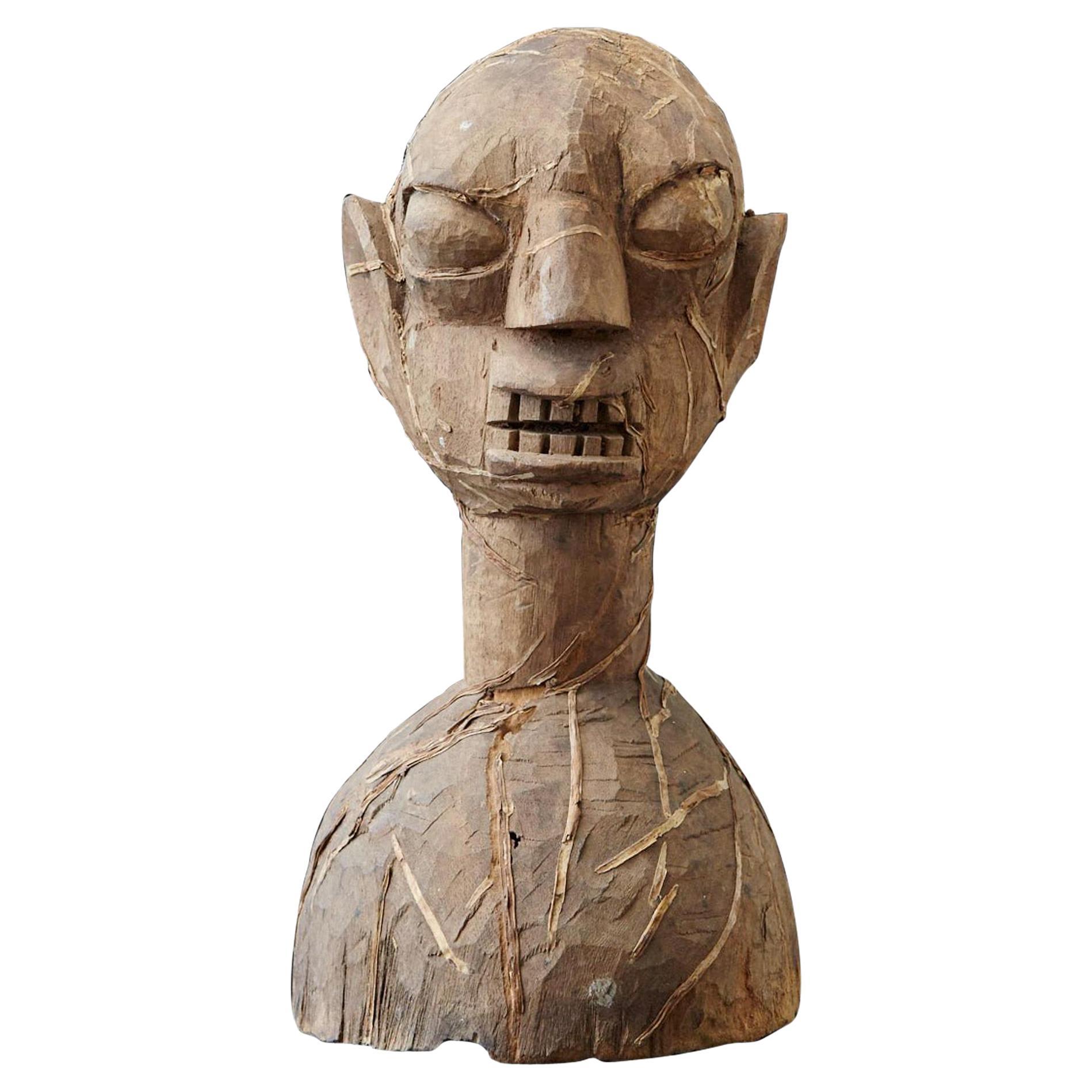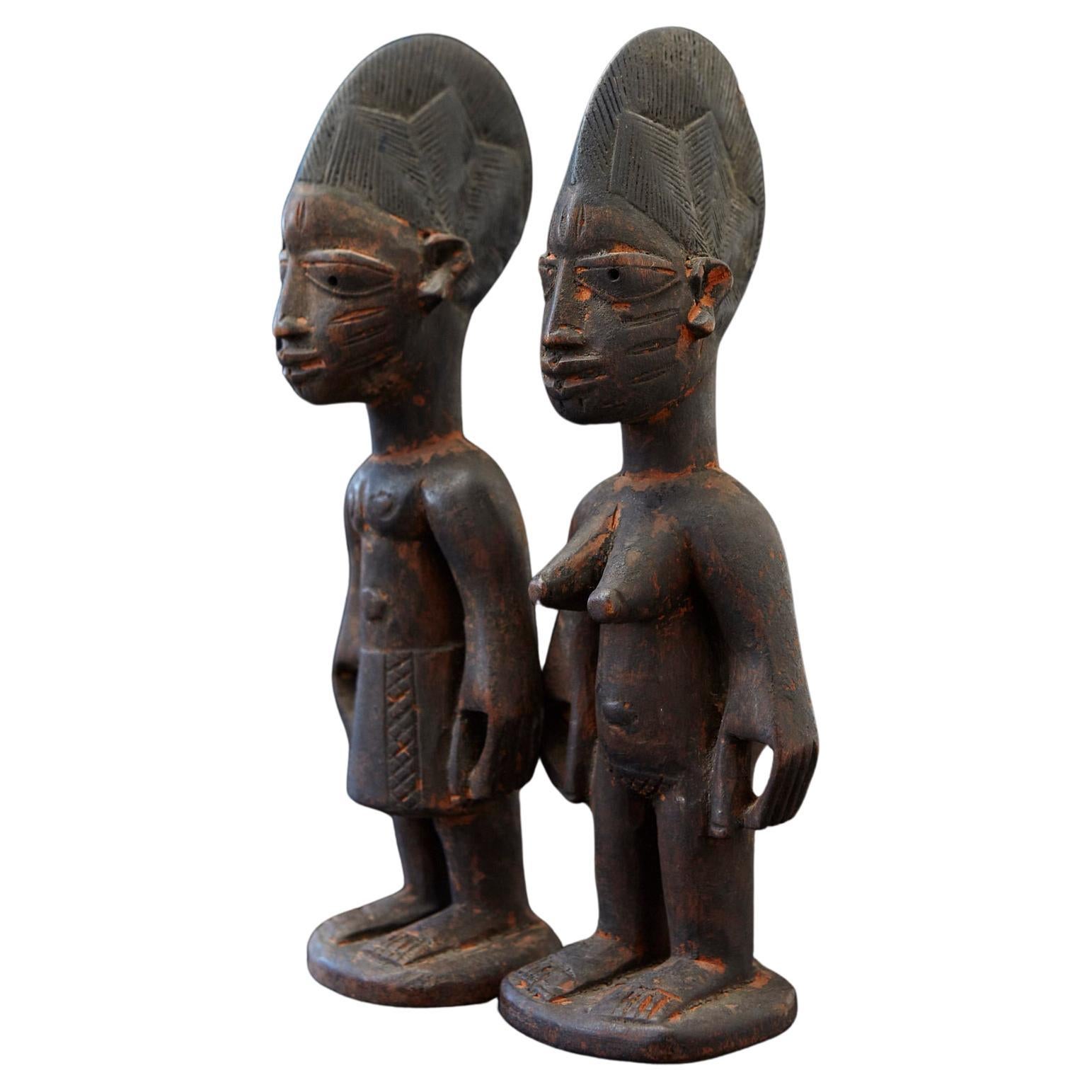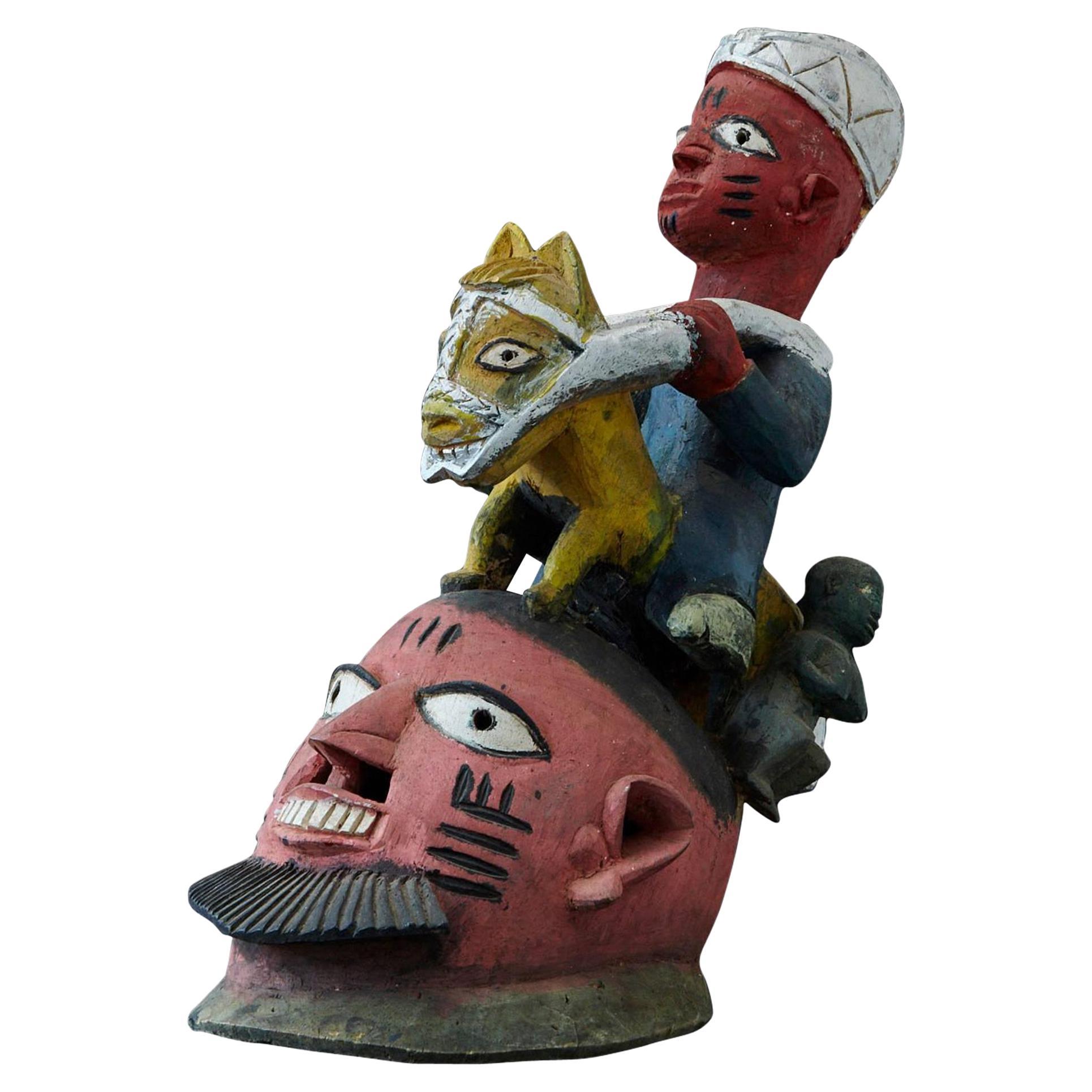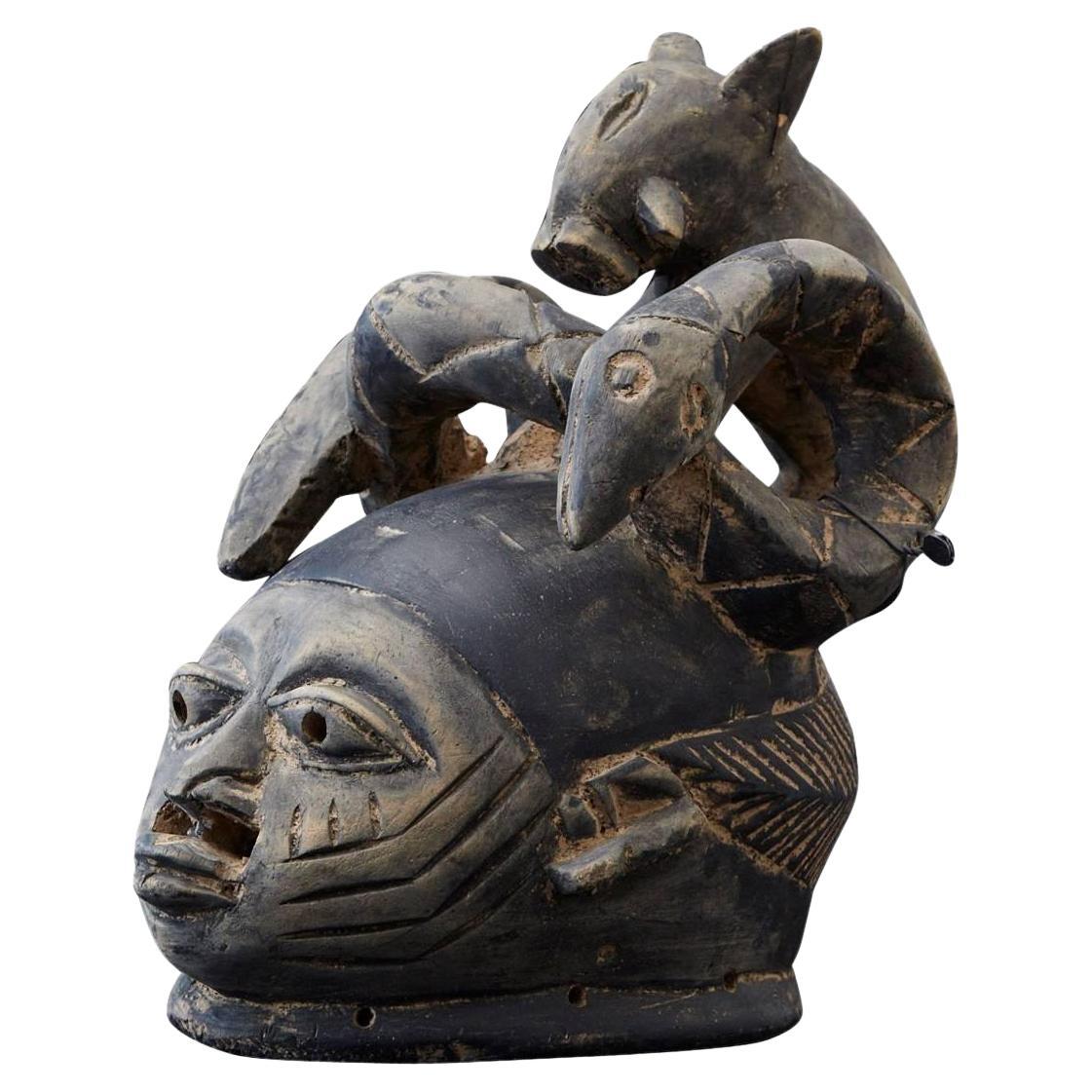Items Similar to Wooden Head of a Wife of an Ooni of Ile-Ife, Yoruba People, Nigeria, circa 1930s
Want more images or videos?
Request additional images or videos from the seller
1 of 12
Wooden Head of a Wife of an Ooni of Ile-Ife, Yoruba People, Nigeria, circa 1930s
About the Item
Wooden head of a wife of an Ooni of Ile-Ife, Yoruba People, Nigeria, circa 1930s.
The Ooni is the traditional ruler of Ile-Ife. The Nigerian town is seen as the cradle of the Yoruba people.
The number is the inventory number from Lehigh University.
Exhibited: The Lehigh University - Art Galleries permanent collection.
Provenance: The collection of Dr and Mrs John E. Swanson.
Dr John Swanson and his wife Marian lived from 1966-1981 in Lagos, Nigeria where Dr Swanson was the Advisor to the National Universities Commission and later on the Chief Planning Officer of the University of Ibadan, Nigeria.
During their time in Africa the Swansons started to collect African art. In 1973 a part of their collection, circa 120 pieces went on loan to The Pennsylvania State University Museum of Art, where the remained until 1978.
In 1981 Dr Swanson passed away and his wife Marian never returned to Africa.
In 1982 Mrs Swanson lent 130 pieces to the Lehigh University Art Gallery where they remained until 1987. A few pieces were also lent to Lafayette College - Williams Art Center for an exhibition titled "Plainly Geometric - Selections of Art from West Africa". In 2018 Mrs Swanson passed away.
- Creator:Yoruba People (Artist)
- Dimensions:Height: 10.5 in (26.67 cm)Width: 7 in (17.78 cm)Depth: 7 in (17.78 cm)
- Style:Tribal (Of the Period)
- Materials and Techniques:
- Place of Origin:
- Period:
- Date of Manufacture:circa 1930s
- Condition:Wear consistent with age and use. Minor losses.
- Seller Location:Aramits, FR
- Reference Number:1stDibs: LU6432227943922
About the Seller
5.0
Vetted Seller
These experienced sellers undergo a comprehensive evaluation by our team of in-house experts.
Established in 2008
1stDibs seller since 2022
12 sales on 1stDibs
Typical response time: 2 hours
- ShippingRetrieving quote...Ships From: Aramits, France
- Return PolicyA return for this item may be initiated within 3 days of delivery.
More From This SellerView All
- Wooden Head of an Ooni of Ile-Ife, Yoruba People, Nigeria, circa 1930sBy Yoruba PeopleLocated in Aramits, Nouvelle-AquitaineWooden head of an Ooni of Ile-Ife, Yoruba People, Nigeria, circa 1930s. The Ooni is the traditional ruler of Ile-Ife. The Nigerian town is seen as the cradle of the Yoruba people. The number is the inventory number from Lehigh University. Exhibited: The Lehigh University - Art Galleries permanent collection. Provenance: The collection of Dr and Mrs John E. Swanson. Dr John Swanson and his wife Marian lived from 1966 - 1981 in Lagos, Nigeria where Dr Swanson was the Advisor to the National Universities Commission and later on the Chief Planning Officer of the University of Ibadan, Nigeria. During their time in Africa the Swansons started to collect African art. In 1973 a part of their collection, circa 120 pieces went on loan to The Pennsylvania State University Museum of Art, where the remained until 1978. In 1981 Dr Swanson passed away and his wife Marian never returned to Africa. In 1982 Mrs Swanson lent 130 pieces to the Lehigh University Art Gallery where they remained until 1987. A few pieces were also lent to Lafayette College...Category
Early 20th Century Nigerian Tribal Tribal Art
MaterialsWood
- Ere Ibeji Pair of Commemorative Figures, Ife, Yoruba People Nigeria early 20th CBy Yoruba PeopleLocated in Aramits, Nouvelle-AquitaineYoruba people have one of the highest incidents of twin births in the world. As a result, twin children are regarded as extraordinary, divine beings protected by Sango, the deity of ...Category
Early 20th Century Nigerian Tribal Tribal Art
MaterialsWood
- Gelede Headdress, Yoruba People, Nigeria, circa 1950sBy Yoruba PeopleLocated in Aramits, Nouvelle-AquitaineGelede festivals honor the creative and dangerous power of women elders, female ancestors and goddesses known as "our mothers". The Gelede headdress often consists of two parts, a lo...Category
Mid-20th Century Nigerian Tribal Tribal Art
MaterialsWood
- Gelede Headdress, Yoruba People, Nigeria, circa 1950sBy Yoruba PeopleLocated in Aramits, Nouvelle-AquitaineGelede festivals honor the creative and dangerous power of women elders, female ancestors and goddesses known as "our mothers". The Gelede headdress often consists of two parts, a lo...Category
Mid-20th Century Nigerian Tribal Tribal Art
MaterialsWood
- Gelede Headdress, Yoruba People, Nigeria, circa 1920sBy Yoruba PeopleLocated in Aramits, Nouvelle-AquitaineGelede festivals honor the creative and dangerous power of women elders, female ancestors and goddesses known as "our mothers". The Gelede headdress often consists of two parts, a lo...Category
Early 20th Century Nigerian Tribal Tribal Art
MaterialsWood
- Polychrome Wood Gelede Headdress, Yoruba People, Nigeria, circa 1940sBy Yoruba PeopleLocated in Aramits, Nouvelle-AquitaineGelede festivals honour the creative and dangerous power of women elders, female ancestors and goddesses known as "our mothers". The Gelede headdress often consists of two parts, a lower mask and an upper elaborate superstructure. The lower mask depicts a woman's face, it's composure expressing the qualities of calmness and patience. The numbers are the inventory numbers from Penn State University and Lehigh University. Exhibited: The Pennsylvania State University - Museum of Art permanent collection; The Lehigh University - Art Galleries permanent collection. Provenance: The collection of Dr and Mrs John E. Swanson. Dr John Swanson and his wife Marian lived from 1966 - 1981 in Lagos, Nigeria where Dr Swanson was the Advisor to the National Universities Commission and later on the Chief Planning Officer of the University of Ibadan, Nigeria. During their time in Africa the Swansons started to collect African art. In 1973 a part of their collection, circa 120 pieces went on loan to The Pennsylvania State University Museum of Art, where the remained until 1978. In 1981 Dr Swanson passed away and his wife Marian never returned to Africa. In 1982 Mrs Swanson lent 130 pieces to the Lehigh University Art Gallery where they remained until 1987. A few pieces were also lent to Lafayette College...Category
Mid-20th Century Nigerian Tribal Tribal Art
MaterialsWood
You May Also Like
- Carved Twin figure Ibeji Yoruba People, NigeriaLocated in Leuven , BEA finely carved significant Yoruba Male Ibeji figure with a tall headdress, expressive eyes, original bead belt and heavy wear and polish from native use. Areas of encrusted camwood ...Category
20th Century Nigerian Tribal Art
MaterialsWood
- Yoruba Four Headed Egungun HeaddressBy Yoruba PeopleLocated in Chicago, ILThis wooden headdress was created by the Yoruba People of western Nigeria, and was worn during a masquerade known as egungun. A widespread Yoruba ritual, egungun performances honor a...Category
Mid-20th Century Nigerian Figurative Sculptures
MaterialsWood
- African Helmet Mask 'Gelede' from Yoruba NigeriaLocated in San Francisco, CABlacked wood helmet mask (Gelede), large human head surmounted by a dog eating a snake which curves around the head. No perforation for attachment to costume from Yoruba, Nigeria. Pu...Category
20th Century Nigerian Tribal Figurative Sculptures
MaterialsWood
- Yoruba (Nigeria) Early 20th Century ClothLocated in Greenwich, CTFine early 20th Century hand spun indigo cotton and Trans-Sahara silk cloth.Category
Early 20th Century Nigerian Tribal Quilts and Blankets
MaterialsCotton, Silk
- Yoruba Ibeji Twin FigureBy Yoruba PeopleLocated in Chicago, ILWith one of the highest rates of twin births in the world, Yoruba cultures place special social and religious significance on twins, referred to as "emi alagbara" or "powerful spirit...Category
Mid-20th Century Nigerian Tribal Tribal Art
MaterialsWood
- Matching Pair of Yoruba Twin Figures Ibeji Nigeria African Tribal Art beadsLocated in Point Richmond, CAMatching rare pair of stocky male twin figures "Ibeji" from the Yoruba people of Nigeria, Africa, created in the early 20th century. Dressed with matching glass bead necklace and bra...Category
Early 20th Century Nigerian Tribal Tribal Art
MaterialsWood
Recently Viewed
View AllMore Ways To Browse
Antique People
1930s Head
Tribal Art From Africa
West African Tribal
African Wood Head
Lafayette Used Furniture
African Tribal Pieces
Ruler Wood
Lafayette Antique
African Carved Heads
Wooden Cradle
Antique Advisor
African Chief
African Wife
Antique Wood Cradle
Antique Rulers Wood
Antique Wooden Cradles
Antique Wooden Cradle





